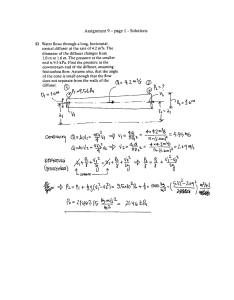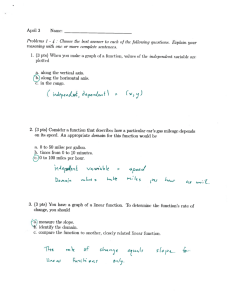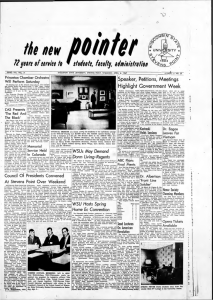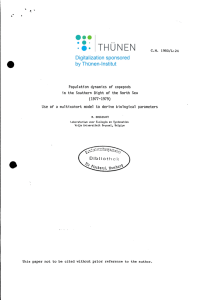•
advertisement
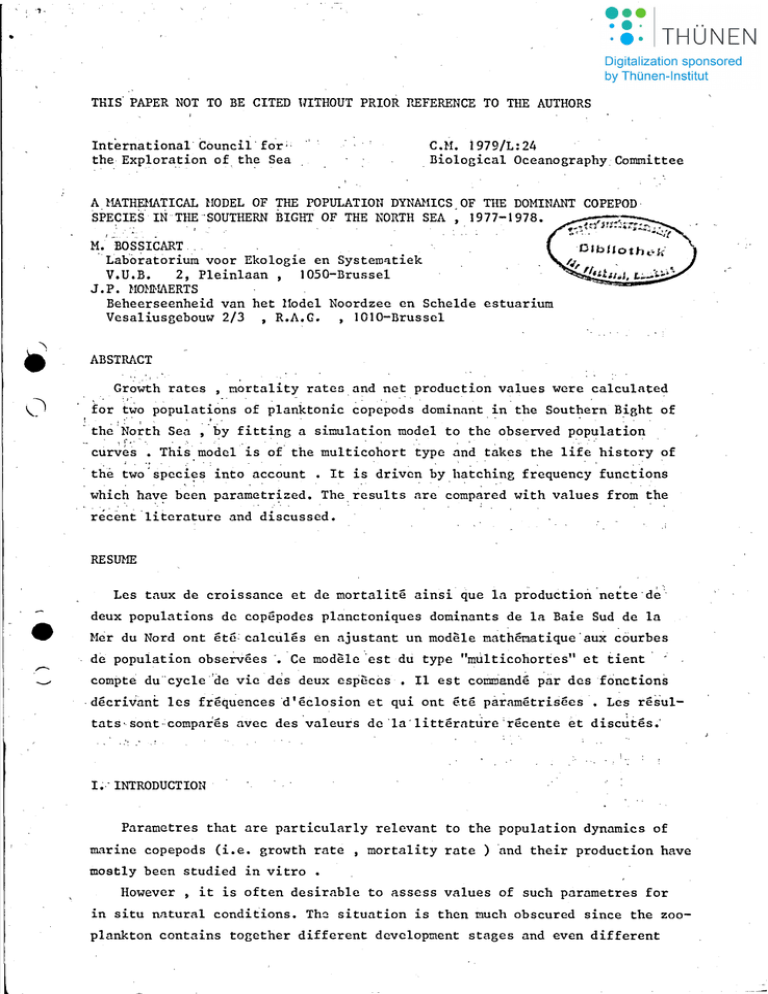
•
TRIS' PAPER NOT TO BE CITED lHTROUT PRIOR nEFERENCE TO TRE AUTRORS
Int~rnational'
Couneil' for;'
the Exploration of. the Sea
C.H. 1979/L:24
,BiologicalOceanographyCommittee
A, HATH~1ATICAL HODEL OF ~HE POPULATION DYNAHICS. OF TRE DOMINANT COPEPOD,
SPE~IES IN TlIE'SOUTRERN BIGHT OF TRE NORTH SEA '. 1977-1978.
M. BOSSICART.
Lahoratorium voor Ekologie en Systero'ltiek
V.U.B.
2, Pleinlaan, 1050-Brussel
J. P. ~10NNAERTS
Beheerseenheid van het lfudel Noordzec cn ScheIde estuarium
Vesaliusgebouw 2/3 , R.A.G. ,1010-Brussel
ABSTRACT
"
.'
(
.
Growth rates , m~rtality raten and not production values ware calculated
~wo populations of planktonic copepods dominant inthe Southern Bight of
for
I,
. ; :"
:
' . .~ '..
'
. •
. : .
,
'the'North Sea , by fitting a simulation model to thc observed population
f
" '.
.
.:.
.'
. '.
' . ' , . ' .
',. ','
.
curves • This model is of' the multicohort type and takes the life history of
, the ~~o'; speci~s .into' acc~unt • It is driven by hatching fr'equency' functions
•
1
~'
.
,
which have been
parametr~zed.
.
The.results are compared with values from the
re~~~t'litcraturc and ·di~~ussed.
RESUME
Les tnux de croissance et de mortalite ainsi que In production 'nette' de",
•
deux populations de copepodes plnnctoniques dominants de la Baie Sud de la
Mer du Nord ont ete: calcules en njustant un modele mnthematique'aux cöurbes
de population observees '. Ce modele "est du type "multicohortes" et dent
compte du"cycle'de vie des deux especes • Il est conmiande par desfonctions
·decrivant les frequences 'd'eclosion et qui ont ete parametrisees • Les resultats,sont·compares aVeC des valeurs de 'lalitterature·recente et discutes:
'.' .
L·'
INTRODUCTlm~
Parametres that are pnrticularly relevant to the population dynamics of
marine copepods (Le. growth rate , mortality rate) 'and their production have
mostly been studied in vitro •
Rowever , it is often desirable to assess values of such parametres for
in situ natural condiiions. Tho situation is then much obscured since the zooplankton contains together different development stages and even different
t
•
2.
generations •.~ ..
In order tc solve this problen of sorting out and cnlculating
pepulaticn.
.
, p'ar:rmetre's 'lind production vnlues , a nulticohort nodel sinulating' the life
history of thc copcpods has becn dcveloped.
;.
.
.
Threc"populations predominatc in thc' 'study area: Ternora longicornis O'.F.
';
..
}1üllcr , rscudocalanus
el~ngatus B~~ck
and - to a lesser extent - hcartia
clausi Giesbrecht • Thc evolution of the two more abundant populations has
been sioulated with the nadel.
II. HETHODS
Sat:lpling was done daily at 4 P .H. froI!!. thc lightship "Hest Hinder~'
(2~'26;20"E 51°23'00"N) fron January to' July during the years 197.1 and 1978.
Fiftylitres of sea,qater 'Here punped fron a depth of 3 metres and filtered
. \'-':'.
on a 50
.
.' , . ~
'.
ni~ronetres
mesh net • The chaice of a single depth was possible be-
'~~~~e ofth~
good vertical homogcneizaticn.of the water i~ this part of the
:.
.
.,'~
,
liorth Sea • The collected material was preserved with neutralized 4 i. fornalin • When counting , a particular attention was g1ven.to proper/identi~i~a­
tion of the various development stages , including the nauplii •
III. RESULTS' OF ·THE ENUHERATIONS
• Figs. l(a,b) and 2(a,b) show the seasonal evolution cf numbers for the
three categorics of development stages in thc predominnting populations. These
curves are,smoothed , using a floating-average technique.The sensonal
.evolution of Pseudocalanus and Tenora clearly shows a succession of thrce generations. These population curves.nre synchronizecl far both species but
with a narked opposition between thc abundance patterns which is suggestive
of interspccific competition.
We have so far no explanation for thc higher numbers of nauplii observed
in 1978 •
".:
•
3.
IV. THE SnmLATIOJ:. !;ODEL
I. Short description
rGd~cer,
This model
basic CievelopIT.2nt etage
tl!c
li~
history of the copepods to their three
: ncmplii , copepodites and <'..dults emd I'lakes the
Ratc~
~ßQ
für each dev.lop_ent s'
• 30:1
CL
,
are
~ssuI':led
to
rena~n
D2tter results are obtaine
constant
if the
nortality rate is incrcnse6 ..:ht:Il -.:ho r..umbers are ffi'lxiTICll (in agreement with
the observation of num2rous cr.:Jp'·y c rapCices at such tiPles ).
Fo
eac.h r;encratio.
netrize
These
,
t
e c.-v01t.:tion cr ti1e number daily hatched is para-
fun~tion3
gi e theiL pace to the whole system.
2. Equations (ay~.1l:>ols are c :r1aiuod ~n table 1 )
2. ]. th
A n nn-
hate:.ing fune tio.
l~iT
describe", thc
pheno~:lenon
(1 )
2.2. equation for the
Fer acchort j
raup~iar
stages
,the nU::lbers ()f individuals deerease
thc ex onential mortality rat8
~n
funetion of
01
(2)
Hence , thc nU::l'er of
t
o
nnd
t
i1'"'P 1
.r
Nt
~
-i
2.3. equl1tior...
=
individuels at a tiI'lc t between
:
~s
f
liviJ~
b e
-c (t
- ß
-
. )2
~1
- TI] i]
di]
(3)
0
for tl:c other de"vclopment staees
Similar equations are Qcvelopcd for thc copepodites ann the adults
i:;('pZ
f b
l,,'"' 0
.::..
(4)
4.
(5)
2.4. equations for the net pro uction
Combining the equation for the net produetion of a single individual
(e.g. a nauplius) during a
8~ven
day (e.r,.
i
1
)
(6)
with the equation f"r the nünbers (e.g. equation (3) )
i 1=Pl
-a (t - ß
N
p =
b e
f
t
i 1= 0
-
. )2
~1
V. RESULTS OF THE FITTI'G OPERATIONS
- filii
A~ID
N k 1i 1 (e k 1
B0 e
-
•
ne has
1) di
(7)
1
(/
DISCUSSION
The population curves generated by the nadel • after fitting , are
givcn in fir.s. I (e.cl) and 2(c,d) • As ean be seen, the agreement with the
observed curves is f,ood. The values of the vari us parametres eqleulated
~n
this way are given in table 2 .
I. Life span: according to the simulation, the life span of an individual
tends to decrease with the
~eneration
number in both species • The life
span camputed for Temora variesbetween 23 and 39 days . Rarris and
Paffenhöffer (1976) have determined values in the range 21-30 for the
sane speeies growed in vitra • For Pseudocalanus the model gives a span
of 19.5-25 days whereas Paffenhöffer and Harris (1976) find 24-29 days
in vitro. Corkett and Urry (1968) r,ive figures eonprizcd betwec
14 and
116 Gays in vitra.
2. Grmvth rate
aecorcling to the simulation , the growth rate tends to
increase with the generation nunbcr . The rate cam uted for the nauplii
of Tenora
var~es between O.Og anel 0.24 day-1 . Harris anel Paffenhöffer
(1976) find a ranr,e of 0.12-0.21 in vitra. The eopepodites exhibit r,rowth
rates eomprized bctwcen 0.13 nd 0.33 whereas Harris anel Paffenhöffer
(1976) find a range of 0.14-0.54 in vitra. ns far as Pseu~ocalanus is
•
5.
concerned , theslmulation p,ives rates 1n the rahße O~22-0.43 for the
nauplii and 0.14-0.24 for the
copepodite~whereas.the
nbovemcntioned
authors find respc~tively o. 14-0.18and 0.04-0~38 in vitra
3. --·Viable egf,~ : the population curv~s simula~cd inply ninimal numbers .
"i.e. viabla eßßs • These nuobers vary here between 4 and 14 for a
female of Tenorn nnd 7 nnd 33 for a fenale of Pseudocnlnnus.
Hnrris and Pnffenhöffer (1976) find a ranp,e of 17-871 for Tonora in
vitra and Paffenhöffer and Harris (]976) find n ranp,c cf 2-136 for
Pscudocalnnus in vitra.
4. Mortality rate : according to the simulation , the mortality rate
decreases as the developmcnt procceds • Horeover ,ndaptations of the
rate are gonerally not nceded far thc naupliar stnccs : for Tcnora thc
ranBe is 0.10 to 0.22 and for Pseudocalanus it is 0.13 to 0.25 •
Harris and Paffenhöffer (1976) and Paffenhöffer and lIarris (1976) find
respectively 0.012-0.064 and 0.008-0.059 in vitra (rccalculatcd fieures) • Wherc copepodites are conccrncd the ranges computed are 0.0010.3 for
Te~~ra
(0-0.0023 in Harris and Paffenhöffer,197G) and 0.005-0.4
,
for Psctldocalanus (0-0.021 in Paffenhöffer and Hnrris , 1976). There
are na conpnrable data nvailnble for the adults.
Thus , there is Lenerally a r,ood agreeMent betwcen thc fir,ures conputed
for an in situ situation and the fir,ures determined in vitra where life
•
span and p,rowth rate are ccncerncd. Discrcpancies of one or two orders cf .
magnitude are however abserved for thc mortality rate ficurcs • This cnn
be explnined oy the differences existing between the natural environment
and thc aquariun : none seems to be food-lioiting out the natural enviroriment is much nore hazardcus. The diffcrences cbserved in thcnuoters of
viablc eBBs could be cxplained by thc lower probnbility for a female to
reneh maturity in nature •
Thus , in order to nchieve reasonnbly r,ood predictivc properties , an
ioproved zooplankton model , rcgulated by the environmental conditions
prcvuiling in the Southern Bip,ht of the North Sea , should put the emphasis
on the nortality and fertility functions.
6.
REFERENCES
'\i'
Corkett,C.J;. and.Urry,D.L.,1968. J.H!'lr.Biol.Ass.U.K.,48 : ·97-105 •
•
,.
~.
1
;
Harris.,R. P .andPaffcnhäffer ,G.h. , 1976. J .Mar. Biol.Ass. U.1:. ,56 :675-:690
..
.
.. •
;'
:". I ~
••
•
~.::
!
'.'
_ . .
.
.
Paffenhöf~er ,G.A. and Harris ,R. P. , 1976.J •HaT. • Biol.Ass. U.K •• 56 :327-344 •
.,
•
(
,'"
"';r
:.", ..
. ... -\,
..
;.
:\.
"~.',
.
" :\.,
;
.
~
,
I
.
-
•
~
~1
-',
:i ·... t.j
I'
:
,
:.i....:: 1
~ \.~
..•. ·.i
,/
~
..
""1'"
.: '
'.
'.
: !
.'
J •
. J;
(;
:'
•
. r , ' -..
: .
...:.-,
".
: r,
..
... ,-
J
:'
TABLE 1.
LEGENDS OF THE SYMBOLS.
ffl
(1)
.j..J
·rl
,
'\
e
~~
·rl
·rl
..-l
P.
~
ro
Z
'"d
0
P.
p.
.(1)
0
u
ffl
+J
..-l
~
'"d
<r:
Nj
Nj
t
Nt
m1
i1
Pl
rQ2~!~!!Qg~_2~!~~~!~!~
:
Number of nauplii hatched on day j (= cohort j)
Numbers in cohort j, still alive on day t.
Ct
mZ
At
Numbers (all cohorts) observable at time t.
m3
Specific mortality
iZ
i3
Age of a given individual (days)
Pz
P3
Maximum age of a given individual (days).
rat~.
§!Q~~_~g~_E!Q~~~!!2~_E~!~~~!~!~:
Biomass of an individual.
•
Initial biomass of an individual .
Specific exponential growth rate.
Net production (all cohorts) on day t.
ß
b
Coefficient giving the dispersion of the normal curve.
Day with the highest hatched number.
Nurnber of nauplii hatched on day ß.
Table 2.
Developing time
(days)
Growth rate
(day-1)
1
2
1
2
Temora : nauplli 77
---- -78
copepo- 77
dites
78
adults
77
78
total
77
78
13
9
13
8
13
12
39
29
10
9
13
9
14
10
37
28
0.09
0.13
O. 13
0.21
0
0
0.12
O. 13
O. 13
0.18
0
0
3
0.24 .
0.15
0.33
0.27
0
0
Pseudocalanus :
- - - - - - -näupTii 77
78
copepo- 77
dites
78
adults 77
78
total
77
78
7
8
7
7
9
10
23
25
4
6
10
7
11
9
25
22
0.24
0.22
0.20
0.20
0
0
0.43
0.29
0.14
0.20
0
0
0.31
0.29
0.24
0.24
0
0
Generations
>=
3
5
8
5
6
13
10
23
24
5.5
6
6
6
8
8
19. 5
20
I
Viablc eggs
implied
Mortallty rate
(day-1)
1
2
1
2
3
11
4
0.22
O. 2 2~0. 35
O. 1
0.07-40.27
0.001
0.001
0.10
0.10
0.001-10.3
O. 1 7-)0.22
0.00l-70.05
0.001--...0. 1
0.15
0.10
O. 001~0. 15
0.001-0.25
0.001-.,.0.2
O. 001~0. 2
20
29
0.20 .
0.20
0.15
0.20
0.20
0.10
0.25
O. 13
O. 15
0.25
o. 005--70.40 0.1Q-70.25
0.15
0.20
O. 0005~0. 4C 0.05-:>0.40
0.10
0.20
14
4
7
33
.
..
-------~-~
()
TEMORA
LONGICORNIS
•
(O.F. MÜLLER)
(-
~
1\
1\
1\
I\
nauptii
copepoddes
oll
.
..
-ö
0.
~
0
e
u
I \
u
0
0.
"0.0
1 \
VI
adul ts
~
e
1
1
I
\
\
20 10
1
\
o
a.
a.
0.
~
~
o
e
u
0
20 10
\
\\ 1\~
J
I
I
I
I
I
\
"-
10 5
\ II\\
!
'.
"
10 5
\
:. \
:\\
/\ \
I
\
i \\
I
"-
"
I
a
2 1
I
/
I (' \\
I' \\,
\\ I':
\
I
'\
"
,
/
\ 1I
",--' ______ .4"
I
I
2 1
I I.
I '\'
: \
I
I
\
I\
\
\\
b
f\
I\
I \
I \
I \
I \
..
VI
VI
:':
-ö
-0.
~
0
e
I
1
I
\
\
\
I
\
I
\
u
a.
0
a.
a.
:J
o
c
"'
0
o ~
a._
~ 'S
0
u
u
0
u
20 10
20 10
I
\
I
\
Il'\
,A. \ I
i\.\ I
! \I I
! \11
.'! \., \1
,
1
\
I
/
I
\
I
\
I
10 5
10 5
\
I
\
\
I
\
I
I
-n
CO
/
/
2 1
10
20
)0
40
SO
F
fI.O
1
1
I
I
\
I
I
/,
._
/
tO
10
M
-_ .. _------.~ ~~-/~
to. 100
HO
A
110
:/'''\
/,....
IJO
140
I
c
,\.. ~.;"
\
1500
If,()
170
1&0
lto
100
On., I
1977
\
I
\
/
2 1
/
'0
10
JO
40
SO
F
60
70
10
'0
/
I
0"
100
;
d
\
."
110
A
I
"
120
I,JO
1.1.0
ISO
'60
"0
180
190
200
0 • .,.
1978
e
('1
PSEUDOCALANUS
ELONGATUS
,1,38700
I I
\
,
BOECK
I \
nouplii
I \
I I
I I
copepodites
odulls
.
'"
.'"
"0
Ci
o
Cl
:>
o
c
I I
I I
I \
"0
:>
Cl
"
Cl
0
c
0
v
0
Cl
c-
Cl
0
'"
I I
I I
I I
I \
20 10
I
\
I
II
\
\\
I
10 5
10
"
(I
5
I \L
A
2
a
1
2
.'"
/
/\...
\ f! \\
\ 1/ ~ I,:
\/1
\--..J,
,~;L---~---
Ci
:>
"
"0
V
0
:>
0
c
\\
I \
Cl
I \
"
Cl
0
I \
v
I \\
20 10
I
I
\
I
\
I
\
I
\
I
10 5
:
..
/-'.
\
'{,
ca
2 1
- .~ ..--::::"..~
'0
10
)()
40
50
f
60
10
10
M
..-
-
fO.
-- .. ..---~ """
-
'00
HO
A
110
I{
....\
,/
,{
\ 1I
\
I
\
'
\
\
c
;:... . \,1/ A'
;[.'
1)0
'''0
M
/
...... ~
ISO
If.O
HO
2 1
I
I
//
190
200
00)'\
1977
10
10
10
40
SO
f
'0
70
10
M
'0
100
'\~
I i \
i
I
I
!I\ ,I ;! \I
! \,
J
\\ I !
\ \, I
,d
".,i
./
UO
A
\ \ II
.'-', \ I,
// ./
'1&0
\
I
I
\
I! \
I \
I ~
I :\\
/'
\
/'.~
I
f\
10 5
\
1"
b
'
f\
1\
0
Cl
0
.. \
'.... ,I
-_...... ,/
'"
Cl
\
I /\ \
Ir', \
'! \ \
~
0
:>
0
C
/
_.......
/
~
I
1
'ö
"0
Ci
1
/
/ \\
\
110
140
UD
M
I~
160
170
ISO
190
'00
D.,.
1978
